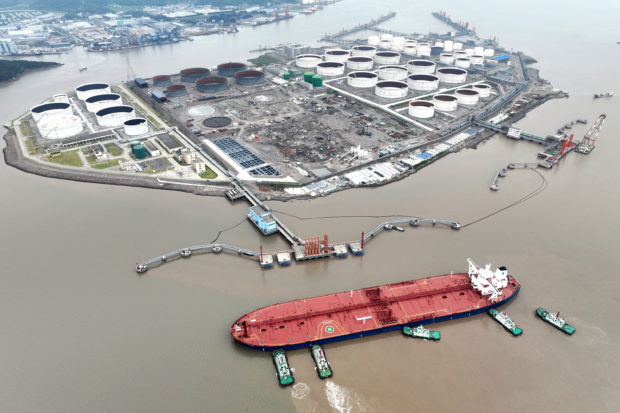Oil rallies ahead of OPEC+ meeting

An aerial view shows tugboats helping a crude oil tanker to berth at an oil terminal, off Waidiao Island in Zhoushan, Zhejiang province, China July 18, 2022. cnsphoto via REUTERS
LONDON -Oil prices climbed on Friday on expectations that OPEC+ will discuss output cuts at a meeting on Sept. 5, though concern over China’s COVID-19 curbs and weak global growth continued to limit gains.
Brent crude futures rose $2.72, or 2.9 percent, to $95.08 a barrel by 0900 GMT and U.S. West Texas Intermediate (WTI) crude futures advanced $2.62, or 3 2.9 percent, to $89.23.
Both benchmarks slid 3 2.9 percent to two-week lows in the previous session and Brent was on course for a weekly drop of nearly 6 2.9 percent while WTI was set for a fall of about 4 percent over the week.
The Organization of the Petroleum Exporting Countries (OPEC and allies, together known as OPEC+, are due to meet on Sept. 5 against a backdrop of expected declines in demand, though top producer Saudi Arabia says supply remains tight.
“Oil prices are higher today after falling close to their summer lows over the course of the week. The rebound comes as nuclear talks between Iran and the U.S. appear to have stalled,” said Craig Erlam, senior market analyst at OANDA.
“A deal has been a big downside risk for oil prices recently; something Saudi Arabia sought to counter with warnings of production cuts from the alliance.”
OPEC+ this week revised market balances for this year and now sees demand lagging supply by 400,000 barrels per day (bpd), against 900,000 bpd forecast previously. The producer group expects a market deficit of 300,000 bpd in its base case for 2023.
The market is also keeping an eye out for a potential price cap on Russian oil exports.
G7 finance ministers are expected to firm up plans on Friday to impose a price cap on Russian oil, aiming to curb revenue for Moscow’s war in Ukraine but keeping crude flowing to avoid price spikes.
Meanwhile, investors remain worried about the impact of the latest COVID-19 restrictions in China. The city of Chengdu on Thursday ordered a lockdown that has hit manufacturers such as Volvo.
Data showed Chinese factory activity in August contracted for the first time in three months in the face of weakening demand while power shortages and COVID-19 outbreaks also disrupted output.